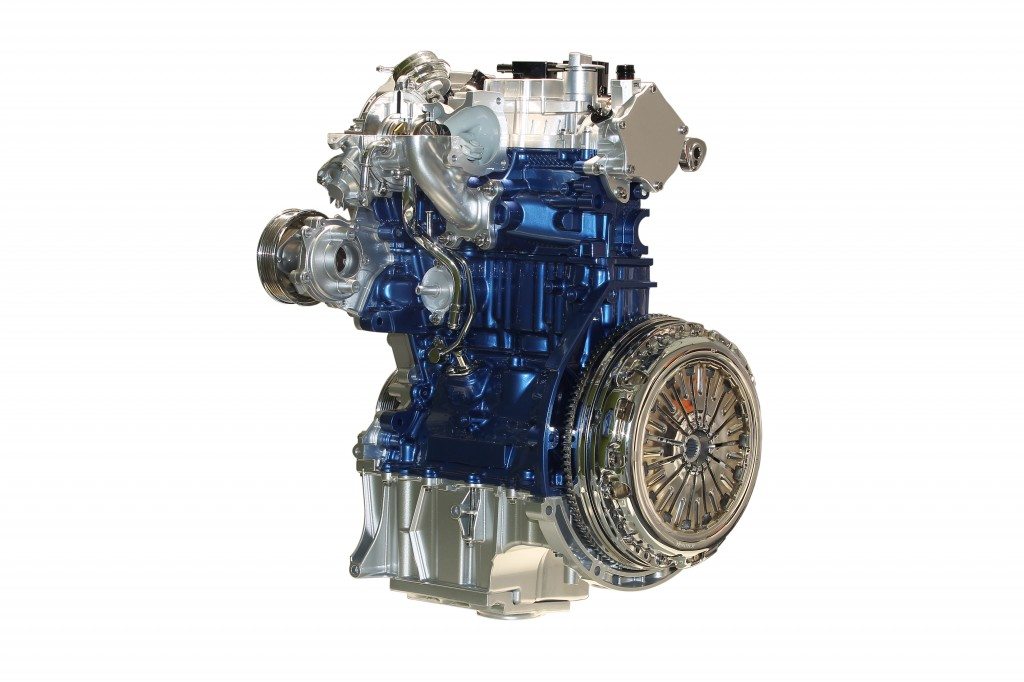Earlier this week, the Ford EcoBoost 1.0-liter engine won the 2014 International Engine of The Year Award. The prize is given to the best engines in different categories and are judged on fuel economy, smoothness, performance and drivability. The 1 liter Ecoboost excels in just about every category, with its punchy acceleration and remarkable fuel efficiency, this three-cylinder engine can take on any competition. Other runner-ups in the Ecoboost’s category included BMW, Volkswagen, Fiat and Renault. Let’s take a closer look at the engineering behind the Ford Ecoboost engine. 
Why EcoBoost?
Ford designed the EcoBoost technology from the ground up to bring power and torque to small displacement engines, resulting in improved fuel efficiency of up to 20%. Although Ford offers many engine sizes as part of their EcoBoost line, they’ve found great success in the small car market with its tiniest configuration: a one-liter, turbocharged three cylinder engine. With its introduction in 2012, 1.0 liter EcoBoost has set a new bar for performance and efficiency.
Seen by many as a laggard in fuel economy by the turn of the century, Ford has completely repositioned its brand and strategy as the American option for the green consumer. After the market flooded with Japanese and Korean fuel efficient competitors, many car manufacturers got caught off guard and realigned their priorities for the American market. Ford has been selling smaller engine cars in Europe for decades, but those vehicles never appealed the United States consumers until very recently.
1.0-Liter EcoBoost Engine Features
As we mentioned before, the engine is built around one key premise: better torque and power without sacrificing fuel economy. To get the most out of this tiny engine, Ford Team worked hard to rethink the purpose of each part. The build starts with a cast iron engine block, which some might point out as old-school or heavy, as aluminum is the trend on lighter cars. However, Ford engineers assure that since the engine is so small (less than a foot long), the cast iron works on its favor since is stronger and more rigid. Aluminum is used for the redesigned cylinder heads to improve fuel-to-air ratio. The main feature of the 1.0 Ecoboost engine is its turbocharger. The turbocharger acts as a turbine that forces more air and gasoline into the engine, thus producing more power at the same revolutions per minute than a car without it. The engine also uses a proprietary cooling system attached to the cylinder heads, which lowers exhaust temperatures and improves the fuel-to-air ratio. Since the EcoBoost produces so much power in such a small engine, a great amount of friction is generated in the piston chamber, which could negatively affect performance. Ford engineers, however, had an answer for this and redesigned the pistons, adding a special anti-friction coating, low-tension piston rings and low-friction crank seals.
What Cars Use 1.0 EcoBoost?
The smallest EcoBoost engine is found in a wide range of Ford vehicles, including some only available in international markets. The models include Focus, C-Max, B-Max, Fiesta, Ecosport and Mondeo. In the U.S., the 1 liter EcoBoost is best known in the Ford Fiesta, as it has the perfect combination of a small body with a powerful engine. The EcoBoost Ford Fiesta is already in dealerships and you can test drive one today at Lamarque Ford.
–
Lamarque Ford is proud to be one of the premier dealerships in New Orleans, LA. Located in Kenner, LA, Lamarque Ford is committed to providing you the best customer service and vehicle service for the life of your vehicle. Whether you’re on the market to purchase, finance, or service a new or used Ford vehicle, you’ve come to the right place.

Leave a Reply